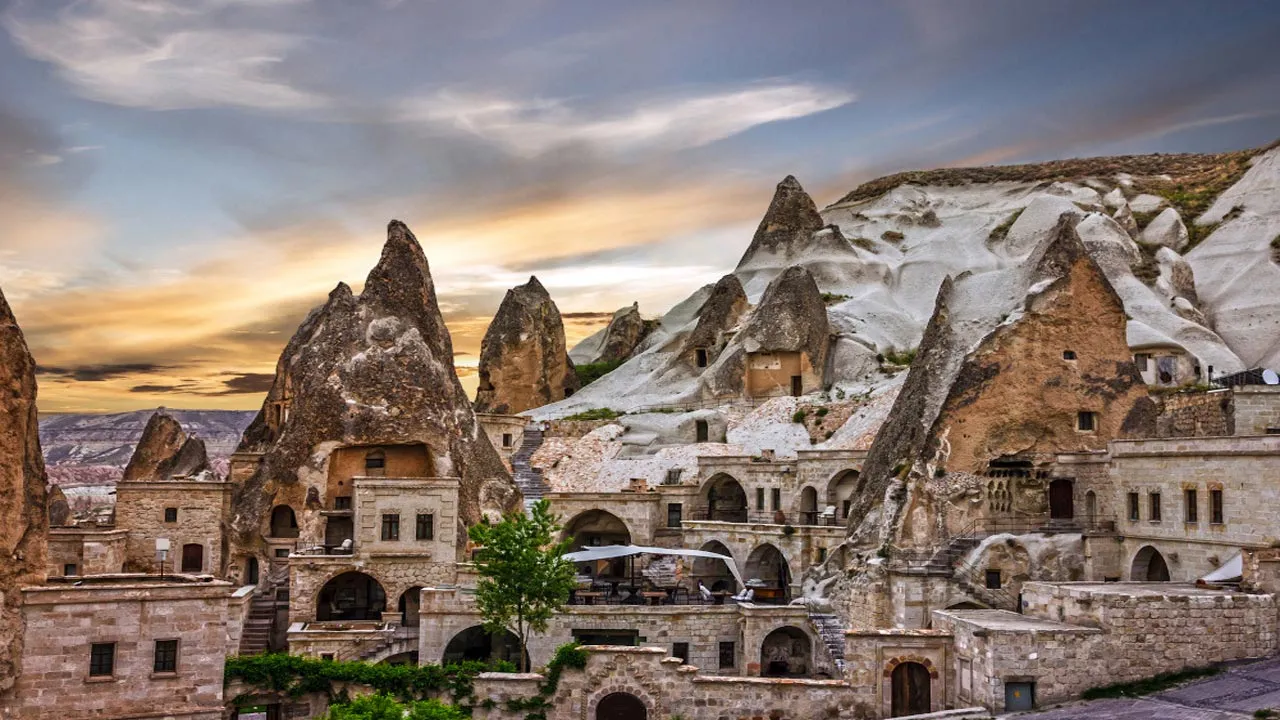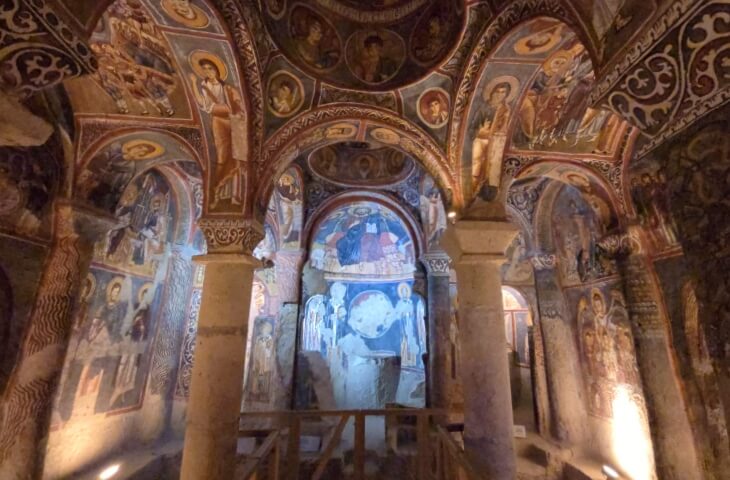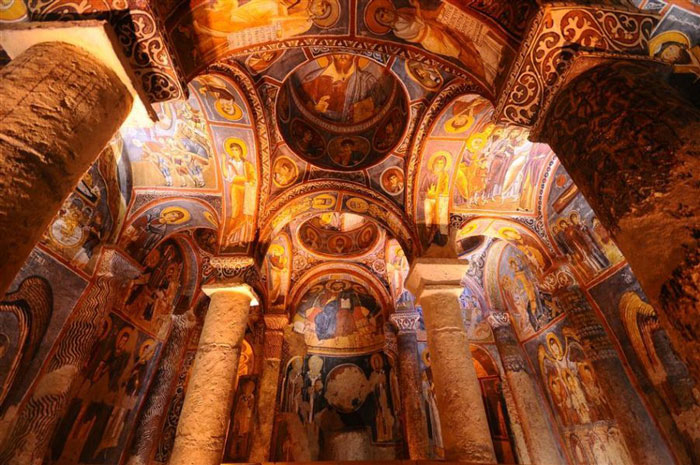So, you're planning a trip to Cappadocia and you're faced with the famous question: With so many places to see, where should I even begin? If you've ever dreamed of traveling back in time to the very heart of a thousand years of history, art, and faith, the answer is actually quite simple. We invite you to the Göreme Open Air Museum, which isn't just a museum but a living encyclopedia of history carved into rock. This is the first and most crucial step to understanding the soul of Cappadocia. So, what are the things to do in the Göreme Open Air Museum, and what secrets will this magical valley whisper to you?
This unique complex was the center of monastic life from the 4th to the 13th century, with churches, chapels, dining halls, and living quarters carved into every rock block. It's no coincidence that it has been a UNESCO World Heritage Site since 1985. This visit promises much more than just beautiful photos; it's about bearing witness to the beliefs, art, and struggles for survival of the people who once lived here. If you're ready, let's begin this unforgettable exploration into the heart of Cappadocia!
Explore the rock-cut monasteries, churches, and chapels

The moment you step into the Göreme Open Air Museum, you're greeted not by an ordinary archaeological site, but by a labyrinth of rock. Here, almost every rock block has a story, and every carving has a purpose. This valley was once home to hundreds of monks and nuns who spent their entire lives within these rocks to live and preserve their faith. Now, let's take a closer look at some of the most impressive structures.
The Fortress of Monastic Life: The Monastery of Nuns and Monks
The massive rock formation that greets you immediately to the left of the entrance is the Monastery of Nuns, which you can think of as a 6-7 story apartment complex. With its dining hall, kitchen, chapel, and rooms connected by tunnels between floors, this self-sufficient living space once housed nearly 300 nuns. This vertical architecture not only saved space but also served as a defense strategy. In times of danger, the entrances to the tunnels were sealed with massive rolling stone doors, turning the monastery into a veritable fortress. This structure highlights how crucial it was to be both a spiritual sanctuary and a physical shelter during that era.
The Monastery of Monks, located directly opposite, has a similar structure, but due to erosion, only the ground floor is accessible today. These two buildings are the most concrete evidence of the organized and populous religious community that once thrived here.
Sacred Spaces at Every Turn
As you wander through the museum, your path will lead you to numerous chapels and churches, both large and small. Each has its own unique character.
St. Basil's Chapel: Located right at the entrance of the museum, this 11th-century chapel welcomes you with a simpler artistic style. The decorations on the walls are not frescoes but simple crosses and geometric patterns painted directly onto the rock with red ochre. This indicates that it bears traces from the iconoclastic (anti-image) period of Christian art in the region.
St. Barbara's Chapel: Named after the patron saint of Byzantine soldiers, this chapel stands out with its wall decorations. Instead of scenes from the Bible, you'll find geometric patterns, mythological animal figures, and military symbols drawn in red paint. These mysterious symbols suggest that the chapel may have been used as a place of offering by soldiers of that time.
Snake Church (Yılanlı Kilise): It gets its name from the most famous scene on its wall: a fresco of St. George and St. Theodore on horseback battling a dragon (which the locals likened to a snake). This church is notable for its unfinished structure and eclectic iconography. Alongside the dragon scene, you'll also find depictions of the Roman Emperor Constantine the Great and his mother, Helena.
The Secrets Behind Their Names: The Apple and Sandal Churches
Some churches get their names from the frescoes inside or from local legends. Here are two of the most interesting ones:
Apple Church (Elmalı Kilise): With its nine domes and four columns, this is one of the most magnificent structures in the museum. There are two theories about its name: either from an apple tree that once stood in front of it or from the orb held by the Archangel Michael in the main dome, which was thought to resemble an apple. The well-preserved frescoes inside vividly depict important scenes from the Bible.
Sandal Church (Çarıklı Kilise): The most captivating detail of this church is the fresco from which it is said to derive its name. Just below the scene depicting the Ascension of Jesus, there are two footprints carved into the rock. According to local belief, these marks represent Jesus's last steps on Earth, hence the name Sandal Church. The geological structure of Cappadocia not only allowed for the carving of these churches but also for the formation of many other natural wonders, like the fairy chimneys in Avanos.
Marvel at the well-preserved frescoes in the Dark Church and the Buckle Church

While all the churches in the Göreme Open Air Museum are precious, there are two that can be considered the pinnacle of Cappadocian art. The Dark Church and the Buckle Church are two masterpieces that will make you feel as if you are walking through an art gallery, captivating you with the stories on their walls. Visiting these two churches is like a journey into the most brilliant period of Byzantine art.
The Secret of Time: The Vibrant Colors of the Dark Church
The Dark Church did not get its name by chance. Apart from a tiny window in the narthex (entrance hall), it receives almost no light. This darkness has been its greatest protector over the centuries. Shielded from sunlight and external elements, the frescoes have preserved their vibrant and bright colors as if they were painted yesterday. To enter this church is to see the true color palette of the 11th century.
The walls, like an illustrated Bible, depict the most important moments from the life of Jesus Christ: scenes such as the Last Supper, the Betrayal of Judas, the Crucifixion, and the Ascension are rendered with incredible detail and emotional depth. An interesting part of its history is that the church was used as a pigeon house until the 1950s, and it took 14 years to clean the pigeon droppings from its interior. The extra entrance fee to protect this unique art treasure is a small price to pay to pass this time capsule on to future generations.
A Masterpiece: The Dazzling Blue of the Buckle Church (Tokalı Kilise)
Located slightly outside the main museum complex, across the road, the Buckle Church is the oldest and largest known rock-cut church in the region. This structure, consisting of four different spaces, is an architectural marvel that shows how it grew and developed over time. However, what truly makes the Buckle Church unique is the lavish use of lapis lazuli pigment, a rare and valuable deep blue, adorning its walls.
The church's barrel vault is decorated like a comic strip with more than 30 scenes depicting the life of Christ. This continuous narrative, starting from the Annunciation and extending to the Ascension, showcases the mastery of storytelling in Byzantine painting. Visiting the Buckle Church is not just looking at walls; it's like reading a sacred text.
| Church Name | Estimated Date | Distinguishing Feature | Must-See Scene |
|---|---|---|---|
| Dark Church | 11th-12th Century | Best-preserved, vibrant frescoes; requires an extra entrance fee. | The Last Supper, The Crucifixion |
| Buckle Church | 10th-11th Century | The largest church in the region; stunning lapis lazuli blue tones. | The complete 30-scene cycle of the life of Christ. |
| Apple Church | 11th-12th Century | Symmetrical architecture; structure with 9 domes. | Christ Pantocrator and depictions of angels. |
| Snake Church | 11th Century | Unfinished structure; unusual and eclectic frescoes. | Mounted saints (St. George & Theodore) slaying the dragon. |
| Sandal Church | 12th-13th Century | The legendary holy footprints from which it gets its name. | The Ascension of Christ (Anastasis). |
Witness the thousand-year-old traces of monastic life

As fascinating as the artworks on the walls of the Göreme Open Air Museum are, the life that was lived within those walls is just as intriguing. For nearly a thousand years, this was not just a place of worship, but also a center for education, production, and community life. The silence of these rocks holds the memory of hundreds of hearts that once beat here, the prayers that were recited, and the bread that was shared.
The Birth of a Community: The Teachings of St. Basil
So, why did so many people renounce the world and gather in this valley? The answer lies with St. Basil of Caesarea (Basil the Great), who lived in the 4th century. St. Basil was the one who brought Christian monks out of solitary, ascetic lives and gathered them under one roof, establishing the rules for communal monastic life. His teachings encouraged monasteries to be not only places of worship but also schools, hospitals, and centers for social welfare. The Göreme Valley is considered the first place where this monastic education system was initiated. Every structure here is a reflection of St. Basil's philosophy of community and service.
Daily Life Inside the Rocks
Monastic life was not just about prayer. The monks and nuns produced their own food, made their own wine, and carried out daily chores together. The refectory (dining hall) you will come across while touring the museum is one of the best examples of this communal living. The long table and benches, carved from a single piece of rock, help you imagine a scene where dozens of people ate together.
Next to the refectory, you'll find kitchens, cellars, and storerooms. These spaces show that the monastery was a self-sufficient economic unit. Even the architecture itself reflects this philosophy. The integration of sacred spaces (churches, chapels) with common living areas (dining hall, kitchen) is the physical embodiment of St. Basil's teaching carved in stone: spiritual life cannot be separated from community life. When you see that rock-cut table, you are not just looking at old furniture, but at the physical evidence of a revolutionary idea that shaped Eastern Christianity.
Don't Let Your Göreme Adventure End Here!
The Göreme Open Air Museum is just the beginning of the riches Cappadocia has to offer. After completing your tour of this magical valley, there are wonderful alternatives nearby waiting for you to continue your adventure.
Uçhisar Castle: Wouldn't you like to see the valley you've been walking through from a bird's-eye view? By climbing Uçhisar Castle, the highest point in the region, you can enjoy a panoramic view of the entire Cappadocian landscape.
Paşabağları (Monks Valley): To see how monks lived a more reclusive life before the communal monasticism of Göreme, visit Paşabağları. The multi-headed, hatted fairy chimneys here are not only great for photos but it's also fascinating to imagine that a monk once lived inside each one.
Avanos: To combine thousand-year-old history with a living culture, stop by Avanos. You can visit one of the famous pottery workshops that use clay from the Kızılırmak (Red River), watch the masters at work, and even try making your own pottery. You can discover a similar historical texture to what you saw in Göreme, but in a completely different geography, on our page aboutVanadokya Peri Bacalari.
Bibliography
For more academic and official information, you can visit UNESCO's page on Göreme National Park and the Rock Sites of Cappadocia: (https://whc.unesco.org/en/list/357/).
Frequently Asked Questions (FAQ)
1. What is the entrance fee for Göreme Open Air Museum, and is the Museum Pass valid? Yes, the Turkish Museum Pass (Müzekart) is valid. If you don't have a Museum Pass or are an international visitor, the current entrance fees may vary. For the most accurate information, we recommend checking the official muze.gov.tr website before you go. Please note that a separate ticket is required to visit the Dark Church.
2. How long does it take to visit the museum? We recommend setting aside at least 2-3 hours to comfortably explore the main churches and monasteries, soak in the atmosphere, and take photos. If you are an art and history enthusiast, this time could be even longer.
3. What are the museum's opening hours? The museum's visiting hours differ between the summer and winter seasons. It generally stays open longer during the summer (April 1 - October 31) and closes earlier in the winter. It's best to confirm the current opening and closing times on the official website before planning your visit.


 English
English Türkçe
Türkçe